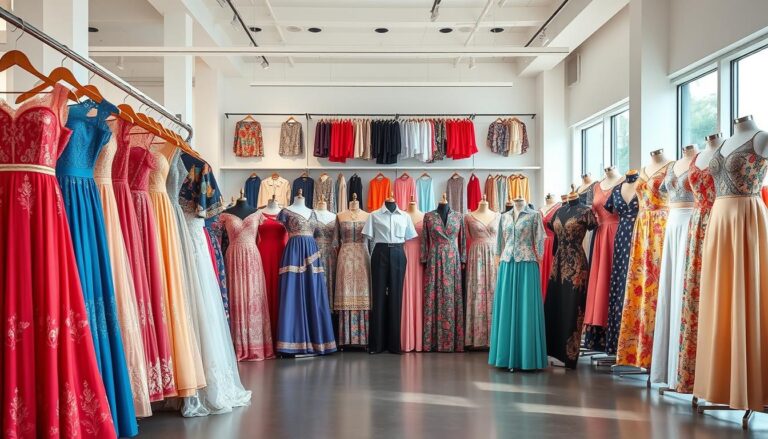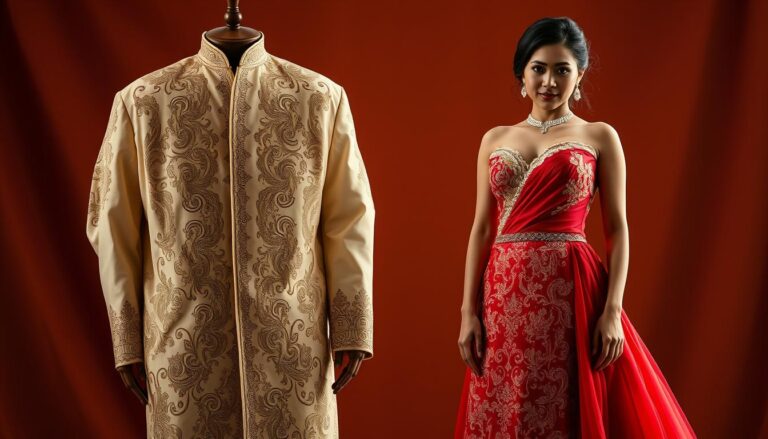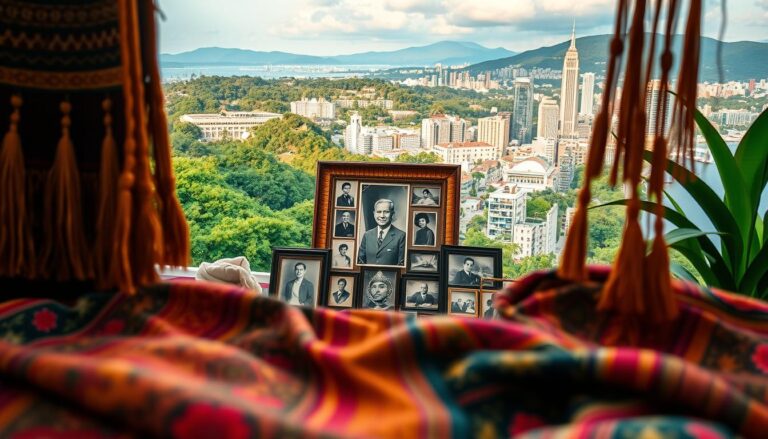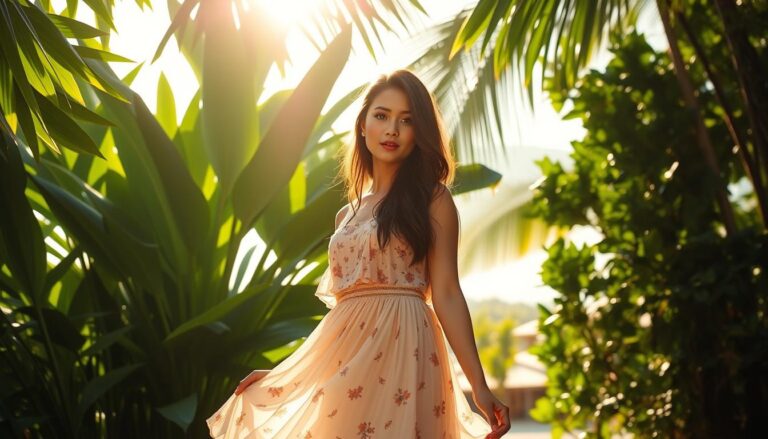Custom vs. Pre-Made Barong Tagalog: What to Consider

Selecting the right formal attire for traditional Filipino events requires careful thought. The Barong Tagalog, a lightweight embroidered shirt, is a cornerstone of cultural pride and modern style. Whether you prioritize personalization or convenience, understanding your options ensures you honor tradition while embracing practicality.
Quality materials and craftsmanship define this garment’s appeal. Premium fabrics like pineapple-derived piña or sleek organza elevate its elegance, while expert tailoring ensures a sharp fit. Brands like MyBarong simplify choices with three departments: ready-to-wear options, tailored pieces crafted in three weeks, and fully customized designs.
Custom creations let you choose intricate embroidery, unique fabrics, and sleeve styles. These details reflect personal taste and cultural heritage. Pre-made versions, however, save time with standard sizing and immediate availability. Both paths impact how confidently you wear barong at weddings, galas, or family gatherings.
Balancing tradition with contemporary fashion is key. This guide explores how fabric quality, design flexibility, and fit shape your decision—so you can celebrate Filipino culture in a garment that feels authentically yours.
Key Takeaways
- Quality fabrics like piña or organza influence the garment’s elegance and comfort.
- Custom options offer embroidery, unique materials, and personalized designs.
- Pre-made barongs provide quick solutions with standard sizing.
- A perfect fit enhances both appearance and confidence during events.
- Traditional craftsmanship meets modern style in today’s Barong Tagalog.
Custom vs. Pre-Made Barong Tagalog: Understanding Your Options
Balancing cultural heritage with modern practicality shapes how men approach this iconic garment. Whether prioritizing individuality or efficiency, each choice reflects personal needs and event requirements.
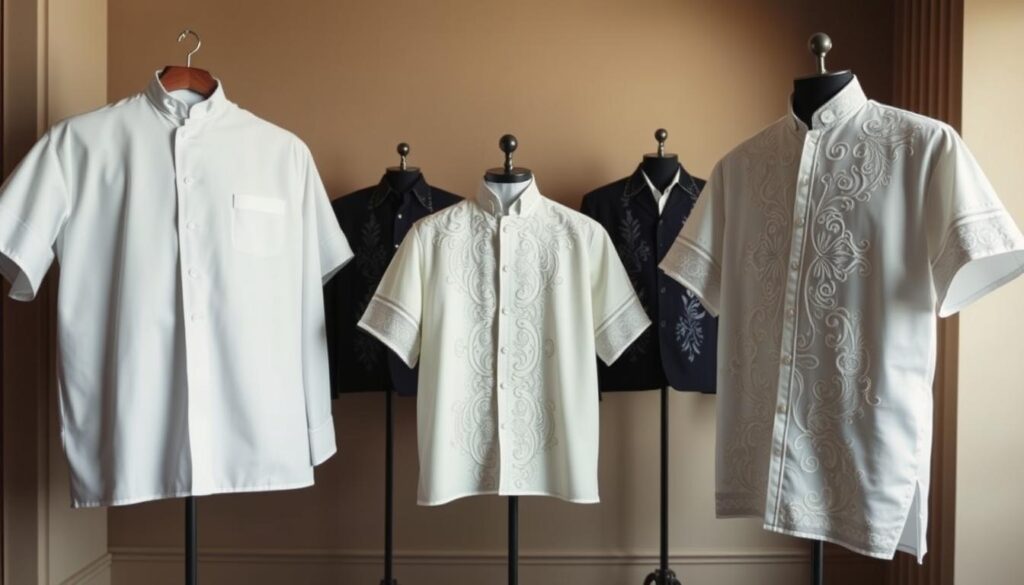
Tailored Creations: Precision and Personal Expression
Opting for a custom-tailored barong unlocks endless design possibilities. Skilled artisans adjust sleeve lengths, collar styles, and body contours to match exact measurements. Clients select from luxurious fabrics like pineapple-derived piña or silk-blend jusi, which influence texture and drape.
Embellishments elevate uniqueness. Intricate floral patterns or geometric embroidery can highlight cultural motifs. This approach ensures the garment aligns with specific occasions, from weddings to milestone celebrations.
Ready-to-Wear Solutions: Speed and Simplicity
Pre-made versions cater to those needing immediate solutions. Standard sizes simplify shopping, while materials like breathable organza offer comfort for office events or frequent use. These options often feature subtle patterns suitable for multiple gatherings.
While less personalized, off-the-rack barongs maintain tradition through classic cuts and neutral colors. They’re ideal for last-minute invitations or travelers seeking authentic attire without wait times.
Your decision hinges on timing, budget, and how deeply you wish to honor craftsmanship. Both paths celebrate Filipino identity—one through meticulous artistry, the other through accessible elegance.
Key Considerations for Choosing the Right Barong Tagalog
The right Barong Tagalog blends traditional craftsmanship with personal comfort and occasion appropriateness. Three elements define its excellence: material integrity, design harmony, and adaptability to events.
Quality Materials and Workmanship
Piña fabric, woven from pineapple fibers, remains the gold standard for formal gatherings. Its delicate texture demands skilled hands during embroidery, ensuring patterns like sampaguita blooms stay crisp for decades. Jusi, a silk-blend alternative, offers breathability for daytime functions while maintaining opacity.
Organza provides affordability with a subtle sheen—ideal for stage performances or casual weddings. Each material undergoes rigorous quality checks to meet traditional Filipino standards of durability and drape.
Fabric, Embroidery, and Color Options
Lighter hues like ivory or pearl white dominate formal events, while deeper tones work for office uniforms. Embroidery density varies: intricate floral designs elevate galas, whereas minimalist patterns suit business meetings.
Thread choices matter. Metallic accents catch light during evening receptions, while matte finishes maintain professionalism. Always verify stitching tightness—loose threads undermine even premium fabrics.
Fit, Style, and Occasion Suitability
Sleeve construction impacts mobility. Tailored cuts prevent billowing during speeches, while relaxed fits aid comfort in outdoor ceremonies. Collar styles also signal formality—structured wing collars pair with ties for weddings, mandarin necks modernize corporate looks.
For beachside events, opt for shorter sleeves and breezy jusi. Grand ballrooms demand floor-length piña with precise shoulder seams. A well-fitted barong moves with you, honoring tradition without sacrificing ease.
Expert Tips on Customization, Fit, and Care
Preserving the elegance of this cultural attire requires smart strategies. Follow these guidelines to maintain its beauty while honoring Filipino craftsmanship.
Measure Twice, Wear Once
Accurate sizing ensures your garment moves naturally. Use a flexible tape measure and follow these steps:
| Measurement | Method | Tip |
|---|---|---|
| Shoulder Width | From shoulder seam to seam | Keep arms relaxed |
| Chest | Fullest part + 2″ ease | Breathe normally |
| Sleeve Length | Shoulder to wrist bone | Bend elbow slightly |
| Shirt Length | Base of neck to hips | Stand straight |
Pair your barong with a neutral undershirt—v-neck styles prevent visibility. For formal occasions, match it with formal black trousers and leather shoes.
“Always lift the garment from the shoulders when dressing—never pull embroidery threads.”
Fabric-Specific Care Solutions
Delicate materials demand special attention. Hand wash pineapple-fiber pieces in cold water with mild soap. For silk blends, spot clean stains immediately using a white cloth.
Steam instead of ironing to protect embroidery details. Store on padded hangers to maintain shape. Many brands offer free alteration programs—schedule adjustments within 14 days of purchase.
Follow care labels rigorously. As one heritage weaver notes: “Quality lasts when respect meets routine.” Proper maintenance keeps your attire event-ready for decades.
Conclusion
Choosing between personalized and ready-to-wear Filipino formalwear shapes both style and cultural pride. Superior materials like piña or jusi ensure elegance, while tailored fits enhance confidence for weddings or office events. Pre-made options offer convenience with classic colors and breathable fabrics ideal for frequent wear.
Quality craftsmanship remains vital. Intricate embroidery and durable stitching preserve tradition, whether you select custom designs or standard uniforms. Always prioritize care policies—gentle washing and proper storage extend your garment’s lifespan.
Both paths honor Filipino heritage. Personalized barongs reflect unique tastes, while off-the-rack choices suit time-sensitive occasions. Follow this guide to balance modern appeal with timeless craftsmanship.
Your final choice should mirror your lifestyle and event needs. With thoughtful fabric selection and maintenance, a well-made barong becomes a versatile statement piece. Embrace its rich legacy while showcasing your personal fashion sensibilities.

